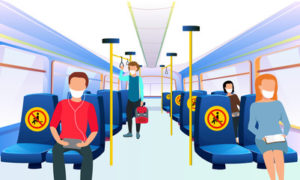
When the quarantine lifts, one of the first questions will be how cities like Seattle can rebuild mass transportation. Currently, transit provides little opportunity to practice social distancing. Some of the most distressing pictures from the pandemic are of closely packed transit riders standing cheek-to-cheek.
reprinted from Seattle Times, May 4, 2020
As we search for solutions, we can speed up a trend that was already in motion. It’s called the flexible workweek. Like teleconferencing, it has its roots in the 1970s and even deeper ones back to the 1930s. Going forward, a shorter workweek, say 32 hours, brings multiple benefits: It helps trains and buses run on time by rebalancing the number of riders; speeds economic recovery by maintaining employment; and helps us prepare for a future with increased automation.
Need to Social Distance
When the economy resumes, many commuters will prefer to drive to work to maintain social distance. They know that they are unlikely to encounter a train or bus with open seats. In Indonesia, the government recently decreed that all public trains, buses, airplanes and ships be allowed to fill only half of their seats to prevent the spread of the COVID-19 virus during Ramadan travel. Closer to home, King County Metro announced that bus drivers should pass up stops once a certain number of riders are already on board. The “temporary optimal/ideal” passenger limits are 12 riders on a 40-foot bus and 18 on a 60-foot bus.
Once those limits are reached, drivers should pass up other customers and the digital signs on the front of buses will read “Coach Full, Sorry.” But, here’s a different option.
What if you could stagger the people boarding the trains and buses? The principle motivating the four-day workweek is simple: Redistribute the number of commuters over a longer period and reduce their ability to bunch.
Different Types of Workweeks
Four-day workweeks can take shape in different ways: Employees can work half-days, take off different days of the week, or, more conventionally, work a 10-hour shift over four days (popular in hospitals). There are news stories praising the shorter workweek coming from New Zealand, Sweden, Japan and beyond. (and, increased telecommuting is surely in the future mix).
For low-paid workers, the downside is a salary that requires belt-tightening. However, the upside is that more people stay in the workforce and earn a salary to put toward groceries and rent. The salary cutback may be a temporary effect: It brings employees into the workforce that might otherwise be furloughed indefinitely, keeps their skills sharp and reduces unemployment insurance.
And History..and Wages
A 30-hour workweek was passed by the U.S. Senate in 1933 for similar economic reasons but failed to get support from President Franklin Roosevelt and business lobbying groups. However, according to the blog timesizing.com, many organizations voluntarily reduced their work hours to reduce unemployment.
For households today, the four-day workweek generates its own income stream that offsets some wage loss. Transportation is the fourth largest household expenditure category in the U.S., with the average household spending close to $10,000 in this category in 2017. Cutting travel by one-fifth yields an offset, particularly for vehicle owners.
Impt: Grow Back Leisure Industry too
Benefits from a 32-hour workweek are likely to extend beyond the early months of the recovery. As it becomes safer to go out, people will resume their discretionary travel trips and resume more leisurely pursuits. The shorter workweek also provides long-term opportunities for households to engage in leisure activities that will revitalize the service and hospitality business.
By 1926, both the Wrigley Gum Company and Ford Motors had shortened the workweek to just five days. Employers, to their great surprise, found that the five-day workweek increased productivity and cut accidents. After learning of the worker satisfaction at Ford, John Maynard Keynes, the economist, predicted that by 2030 or so, people would work just 15 hours a week. We approach that time with urgent needs: We need to run the trains and keep people at jobs. It will likely take an act of government, too, but management and transit operators could enter the 21st century together.